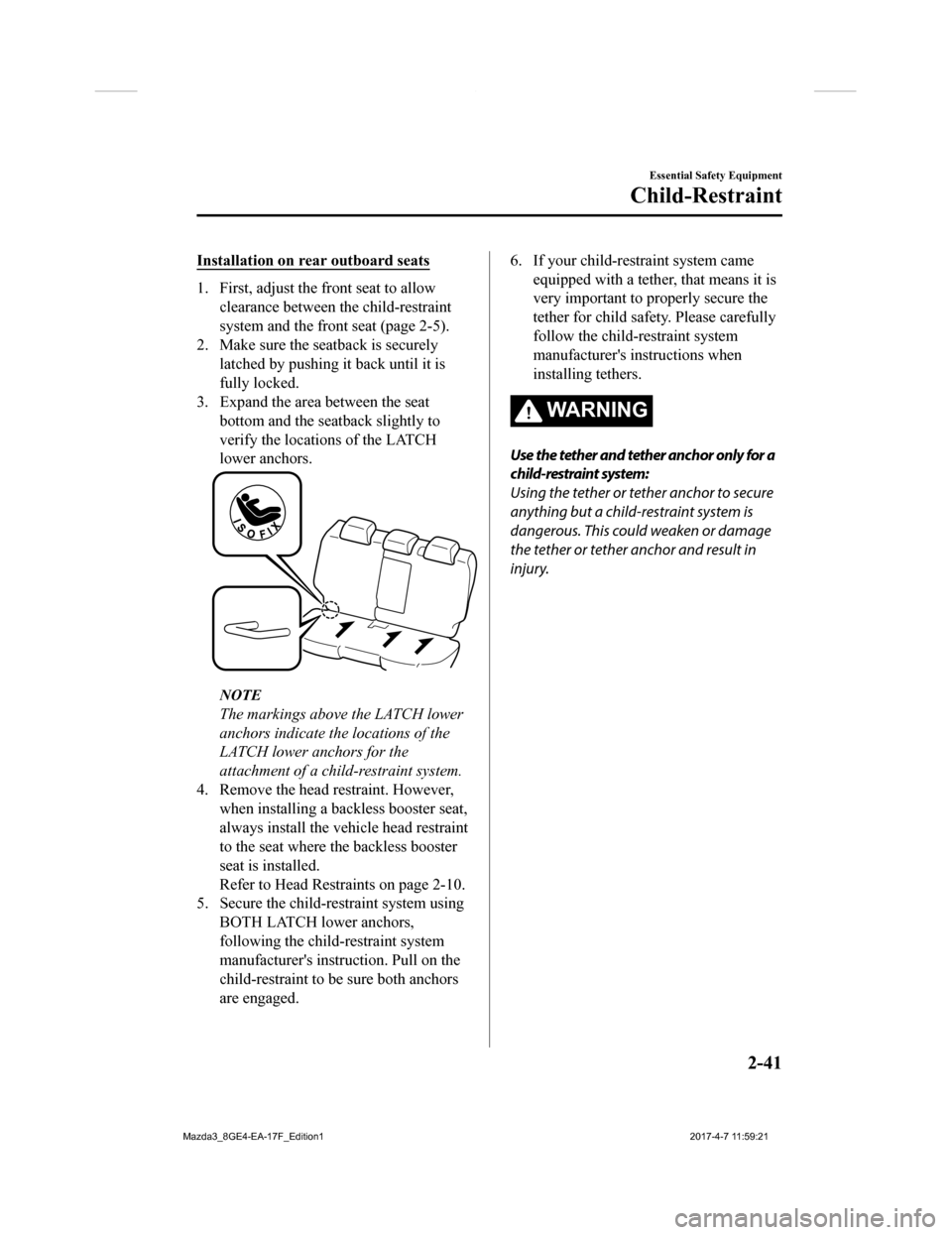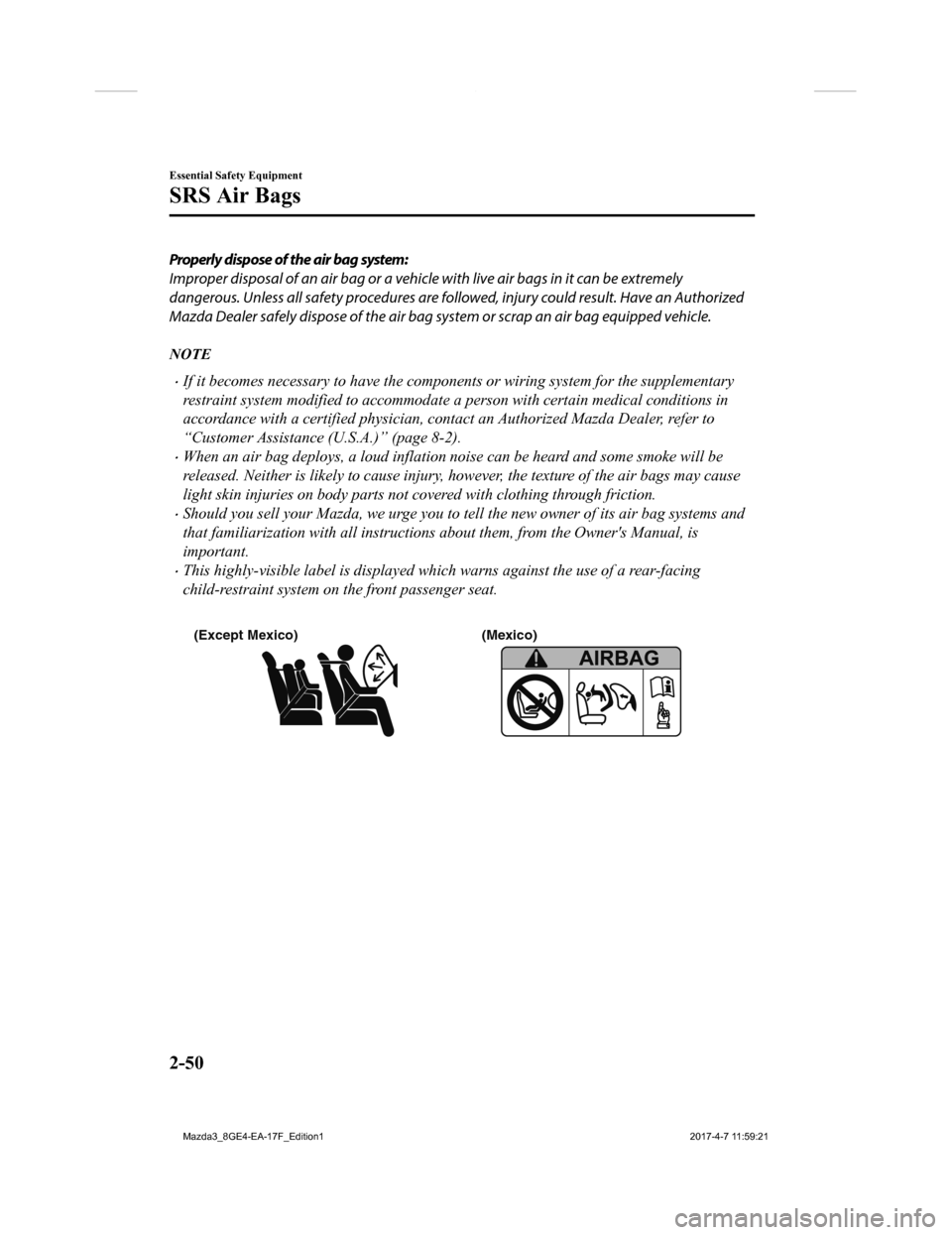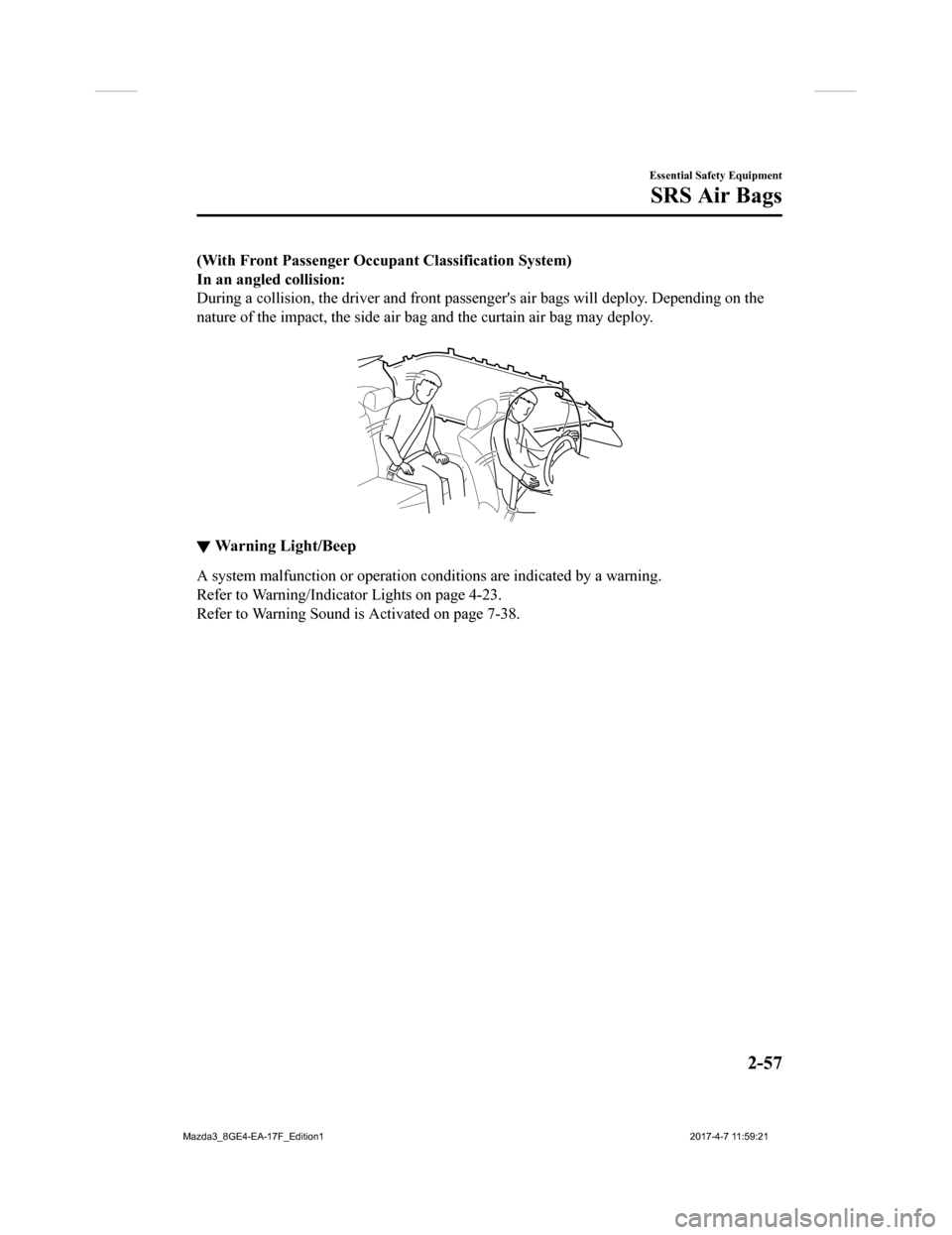light MAZDA MODEL 3 HATCHBACK 2018 (in English) User Guide
[x] Cancel search | Manufacturer: MAZDA, Model Year: 2018, Model line: MODEL 3 HATCHBACK, Model: MAZDA MODEL 3 HATCHBACK 2018Pages: 624, PDF Size: 61.21 MB
Page 37 of 624

Seating a child in a child-restraint system on the front passenger seat is dangerous under
certain conditions (With Front Passenger Occupant Classification System):
Your vehicle is equipped with front passenger occupant classification sensor. Even with the
front passenger occupant classification sensor, if you must use the front passenger seat to
seat a child, using a child-restraint system on the front passenger seat under the following
conditions increases the danger of the front passenger air bag deploying and could result in
serious injury or death to the child.
’āś The front passenger air bag deactivation indicato r light does not illuminate when seating a
child in the child-restraint system.
’āś Luggage or other items are placed on the seat with the child in the child-restraint system.
’āś A rear passenger or luggage pushing or pulling down on the front passenger seatback.
’āś Luggage or other items are placed on the seatback or hung on the head restraint.
’āś The seat is washed.
’āś Liquids are spilled on the seat.
’āś The front passenger seat is moved backward, pushing into luggage or other items placed
behind it.
’āś The front passenger seatback contacts the rear seat.
’āś Luggage or other items are placed between the front passenger seat and driver seat.
’āś An electric device is put on the front passenger's seat.
’āś An additional electrical device, such as a seat warmer is installed to the surface of the front
passenger seat.
The designated positions with seat belts on th e rear seats are the safest places for children.
Always use seat belts and child restraints.
Do not allow a child or anyone to lean over or against the side window of a vehicle with side
and curtain air bags:
It is dangerous to allow anyone to lean over or against the side window, the area of the front
passenger seat, the front and rear window pillars and the roof edge along both sides from
which the side and curtain air bags deploy, even if a child-restraint system is used. The impact
of inflation from a side or curtain air bag could cause serious injury or death to an out of
position child. Furthermore, leaning over or ag ainst the front door could block the side and
curtain air bags and eliminate the advantages of supplemental protection. With the front air
bag and the additional side air bag that comes ou t of the front seat, the rear seat is always a
better location for children. Take special care no t to allow a child to lean over or against the
side window, even if the child is seated in a child-restraint system.
Essential Safety Equipment
Child-Restraint
2-23
Mazda3_8GE4-EA-17F_Edition1 2017-4-7 11:59:21
Page 50 of 624

Ō¢╝If You Must Use the Front Seat for
Children
If you cannot put all children in the rear
seat, at least put the
smallest children in
the rear and be sure the largest child up
front uses the shoulder belt over the
shoulder.
NEVER put a rear-facing child-restraint
system on the front passenger seat whether
your vehicle is equipped with an occupant
classification sensor or not.
This seat is also not set up for tethered
child-restraint system s, put them in one of
the rear seat positions set up with tether
anchors.
Likewise the LATCH child-restraint
system cannot be secured in the front
passenger's seat and should be used in the
rear seat.
Do not allow anyone to sleep against the
side window since your vehicle has side
and curtain air bags, it could cause serious
injuries to an out of position occupant. As
children more often sleep in cars, it is
better to put them in the rear seat. If
installing the child-re straint system on the
front seat is unavoidable, follow these
instructions when using a front-facing
child-restraint sy stem in the front
passenger's seat.
NOTE
’éĘTo check if your front seats have side air
bags:
Mazda vehicles equipped with side air
bag will have a "SRS AIRBAG" tag on
the outboard shoulder of the front seats.
’éĘTo check if your vehicle has curtain air
bags:
Mazda vehicles equipped with curtain
air bag will have an "SRS AIRBAG"
marking on the window pillars along the
roof edge.
WA R N I N G
Always move the front passenger seat as
far back as possible if installing a
front-facing child-restraint system on it is
unavoidable:
As your vehicle has front air bags and
doubly so because your vehicle has side air
bags, a front-facing child-restraint system
should be put on th e front passenger seat
only when it is unavoidable.
Even if the front passenger air bag
deactivation indicator light illuminates,
always move the seat as far back as
possible, because the force of a deploying
air bag could cause serious injury or death
to the child.
Never use a rear-facing child-restraint
system in the front seat with an air bag
that could deploy:
Rear-facing child-restraint systems on the
front seat are part icularly dangerous.
Even in a moderate collision, the
child-restraint system can be hit by a
deploying air bag and moved violently
backward resulting in serious injury or
death to the child. Even though you may
feel assured that the front passenger air
bag will not deploy based on the fact that
the front passenger air bag deactivation
indicator light illuminates, you should not
use a rear-facing child-restraint system in
the front seat.
Essential Safety Equipment
Child-Restraint
2-36
Mazda3_8GE4-EA-17F_Edition1 2017-4-7 11:59:21
Page 52 of 624

NOTE
’éĘInspect this function before each use
of the child-restraint system. You
should not be able to pull the
shoulder belt out of the retractor
while the system is in the automatic
locking mode. When you remove the
child-restraint system, be sure the
belt fully retracts to return the
system to emergency locking mode
before occupants use the seat belts.
’éĘFollow the child-restraint system
manufacturer's instructions
carefully.
Depending on the type of
child-restraint system, it may not
employ seat belts which are in
automatic locking mode.
7. Seat your child safely in the
child-restraint system and secure the
child according to the instructions
from the child-restraint system
manufacturer.
8. Switch the ignition ON and make surethe front passenger air bag deactivation
indicator light illuminates after
installing a child-restraint system on
the front passenger seat.
If the front passenger air bag
deactivation indicator light does not
illuminate, remove the child-restraint
system, switch the ignition to OFF, and
then re-install th e child-restraint
system (page 2-61).
Essential Safety Equipment
Child-Restraint
2-38
Mazda3_8GE4-EA-17F_Edition1 2017-4-7 11:59:21
Page 53 of 624

WA R N I N G
Do not seat a child in a child-restraint
system on the front passenger seat if the
front passenger air bag deactivation
indicator light does not illuminate:
While it is always better to install any
child-restraint system on the rear seat, it is
imperative that a child-restraint system
ONLY be used on the front passenger seat if
the deactivation indica tor light illuminates
when the child is seated in the
child-restraint system (page 2-61). Seating
a child in a child-restraint system installed
on the front passenger seat with the front
passenger air bag deactivation indicator
light not illuminated is dangerous. If this
indicator light does not illuminate, this
means that the front passenger front and
side air bags, and seat belt pretensioner are
ready for deployment. If an accident were
to deploy an air bag, a child in a
child-restraint system sitting in the front
passenger seat could be seriously injured or
killed. If the indicator light does not
illuminate after seating a child in a
child-restraint system on the front
passenger seat, seat a child in a
child-restraint system on the rear seat and
consult an Authorized Mazda Dealer as
soon as possible.
Essential Safety Equipment
Child-Restraint
2-39
Mazda3_8GE4-EA-17F_Edition1 2017-4-7 11:59:21
Page 55 of 624

Installation on rear outboard seats
1. First, adjust the front seat to allowclearance between the child-restraint
system and the front seat (page 2-5).
2. Make sure the seatback is securely
latched by pushing it back until it is
fully locked.
3. Expand the area between the seat
bottom and the seatback slightly to
verify the locations of the LATCH
lower anchors.
NOTE
The markings above the LATCH lower
anchors indicate the locations of the
LATCH lower anchors for the
attachment of a child-restraint system.
4. Remove the head restraint. However, when installing a backless booster seat,
always install the vehicle head restraint
to the seat where the backless booster
seat is installed.
Refer to Head Restraints on page 2-10.
5. Secure the child-restraint system using
BOTH LATCH lower anchors,
following the child-restraint system
manufacturer's instruction. Pull on the
child-restraint to be sure both anchors
are engaged.
6. If your child-restraint system cameequipped with a teth er, that means it is
very important to properly secure the
tether for child safety. Please carefully
follow the child -restraint system
manufacturer's instructions when
installing tethers.
WA R N I N G
Use the tether and tether anchor only for a
child-restraint system:
Using the tether or tether anchor to secure
anything but a child-restraint system is
dangerous. This could weaken or damage
the tether or tether anchor and result in
injury.
Essential Safety Equipment
Child-Restraint
2-41
Mazda3_8GE4-EA-17F_Edition1 2017-4-7 11:59:21
Page 59 of 624

If your vehicle is also equipped with a front passenger occupant classification system,
refer to the Front Pas senger Occupant Classi fication System (page 2-61) for details.
If your vehicle is equipped with a front passenger occupant classification system, the front
passenger air bag deactivation i ndicator light illuminates for a specified time after the
ignition is switched ON.
Small children mu st be protected by a child-restraint system as stipulated by law in every
state and province. In certain s tates and provinces, larger children must use a child-restraint
system (page 2-20).
Carefully consider which child-restraint system is necessary fo r your child and follow the
installation directions in this Owner's Manual as well as the c hild-restraint system
manufacturer's instructions.
WA R N I N G
Seat belts must be worn in air bag equipped vehicles:
Depending only on the air bags for protection during an accident is dangerous. Alone, air
bags may not prevent serious injuries. The appr opriate air bags can be expected to inflate
only in the first accident, such as frontal, near frontal or side collisions or roll-over accidents
that are at least moderate. Vehicle occu pants should always wear seat belts.
Children should not ride in the front passenger seat:
Placing a child, 12 years or under, in the front seat is dangerous. The child could be hit by a
deploying air bag and be seriously injured or even killed. A sleeping child is more likely to lean
against the door and be hit by the side air ba g in moderate collision to the front-passenger
side of the vehicle. Whenever possible, alwa ys secure a child 12 years and under on the rear
seats with an appropriate child-restraint system for the child's age and size.
Essential Safety Equipment
SRS Air Bags
2-45
Mazda3_8GE4-EA-17F_Edition1 2017-4-7 11:59:21
Page 64 of 624

Properly dispose of the air bag system:
Improper disposal of an air bag or a vehicle with live air bags in it can be extremely
dangerous. Unless all safety procedures are followed, injury could result. Have an Authorized
Mazda Dealer safely dispose of the air bag sy stem or scrap an air bag equipped vehicle.
NOTE
’éĘIf it becomes necessary to have the components or wiring system for the supplementary
restraint system modified to accommodate a person with certain medical conditions in
accordance with a certified physician, contact an Authorized Mazda Dealer, refer to
ŌĆ£Customer Assistance (U.S.A.)ŌĆØ (page 8-2).
’éĘWhen an air bag deploys, a loud inflation noise can be heard and some smoke will be
released. Neither is likely to cause injury, however, the text ure of the air bags may cause
light skin injuries on body parts not covered with clothing through friction.
’éĘShould you sell your Mazda, we urge you to tell the new owner of its air bag systems and
that familiarization with all instructions about them, from the Owner's Manual, is
important.
’éĘThis highly-visible label is displayed wh ich warns against the use of a rear-facing
child-restraint system on the front passenger seat.
(Except Mexico) (Mexico)
Essential Safety Equipment
SRS Air Bags
2-50
Mazda3_8GE4-EA-17F_Edition1 2017-4-7 11:59:21
Page 66 of 624

(Without Front Passenger Occupant Classification System)
Driver/Front passenger inflators and air bags
Roll-over sensor*, crash sensors, and diagnostic module (SAS unit)
Seat belt pretensioners (page 2-16)
Front air bag sensors
Side crash sensors*
Air bag/seat belt pretensioner s ystem warning light (page 4-24)
Side and curtain inflators and air bags*
Front passenger air bag deactivation indicator light* (page 2-61)
Front passenger occupant classification sensor* (page 2-61)
Front passenger occupant classification module*
Essential Safety Equipment
SRS Air Bags
2-52*Some models.
Mazda3_8GE4-EA-17F_Edition1 2017-4-7 11:59:21
Page 71 of 624

(With Front Passenger Occupant Classification System)
In an angled collision:
During a collision, the driver and front passenger's air bags will deploy. Depending on the
nature of the impact, t he side air bag and the curtain air bag may deploy.
Ō¢╝ Warning Light/Beep
A system malfunction or operation conditions are indicated by a
warning.
Refer to Warning/Indicator Lights on page 4-23.
Refer to Warning Sound is Activated on page 7-38.
Essential Safety Equipment
SRS Air Bags
2-57
Mazda3_8GE4-EA-17F_Edition1 2017-4-7 11:59:21
Page 75 of 624

Front Passenger Occupant Classification System*
First, please read "Supplemental Restraint System (SRS) Precautions" (page 2-44) carefully.
Ō¢╝Front Passenger Occupant Classification Sensor
Your vehicle is equipped with a front passenger occupant classi
fication sensor as a part of
the supplemental restraint system. This sensor is equipped in t he front passenger's seat
cushion. This sensor measures th e electrostatic capacity of the front passenger's seat. The
SAS unit is designed to prevent the front passenger front and s ide air bags and seat belt
pretensioner system from deployi ng if the front passenger air bag deactivation indicator
light turns on.
To reduce the chance of injuries caused by deployment of the front passenger air bag, the
system deactivates the front passenger front and side air bags and also the seat belt
pretensioner system when the front passenger air bag deactivati on indicator light turns on.
Refer to the following table for the front passenger air bag deactivation indicator light
illumination conditions.
This system shuts off the front passenger front and side air ba gs and seat belt pretensioner
system, so make sure the front passenger air bag deactivation indicator light turns on
according to the following table.
The air bag/front seat belt pretensioner system warning light f lashes and the front passenger
air bag deactivation indicator light illuminates if the sensors have a possible malfunction. If
this happens, the front passenger front and side air bags and s eat belt pretensioner system
will not deploy.
Front passenger air bag deactivation indicator light
This indicator light turns on to r emind you that the front passenger front and side air bags
and seat belt pretensioner will not deploy during a collision.
If the front passenger occupant classification sensor is normal, the indicator light turns on
when the ignition is switched ON. The light turns off after a f ew seconds. Then, the
indicator light turns on or is off under the following conditio ns:
Essential Safety Equipment
SRS Air Bags
*Some models.2-61
Mazda3_8GE4-EA-17F_Edition1 2017-4-7 11:59:21